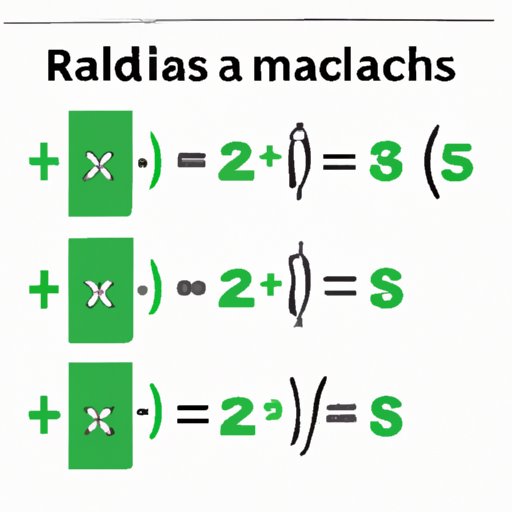
I. Introduction to Radicals
Radicals, also known as square roots or irrational numbers, are numbers that cannot be expressed as a fraction or a whole number. These numbers carry a huge significance in math because they have a fundamental role in various formulas and equations. They typically appear in the form of √x, where x is any positive real number or variable.
II. Steps to Adding Radicals
Adding radicals requires some basic knowledge of algebra. Whether you are dealing with similar or unlike indices, you can follow the simple steps below to add radicals:
Adding Radicals with Similar Indices
When adding radicals with the same indices, you need to:
- Identify the index (the number outside the radical symbol)
- Add the coefficients (the number inside the radical symbol)
- If there are variables, add the variables with the same degree
Adding Radicals with Unlike Indices or Variables
When adding radicals with different indices or variables, you need to:
- Identify the unlike indices
- Simplify the radicals by factoring them
- Add the radicals with the same indices or variables
- If there are variables, add the coefficients and the variables with the same degree
Here are some examples to help you understand how to add radicals with unlike indices:
√12 + √27 = √4 * √3 + √9 * √3 = 2√3 + 3√3 = 5√3
2√6 + 5√24 = 2√2 * √3 + 5√4 * √6 = 2√2 * √3 + 5 * 2√2 * √3 = 14√2 * √3
III. Adding Radicals with Unlike Indices or Variables
Simplifying radicals before adding them not only helps you calculate them easily but also assists in minimizing the possibility of errors while solving them. Here are some tips on how to simplify radicals:
Identifying factors of numbers and variables
Identifying factors of numbers and variables is an essential part of simplifying radicals. The factors of a number are the numbers that divide the original number exactly. For instance, the factors of 9 are 1, 3, and 9. Similarly, the factors of x2 are x and x. Hence, to simplify the radical expression √36, you will identify factors of 36 like 1, 2, 3, 4, 6, 9, 12, 18, and 36. Then you can use these factors to express the original number in terms of factors of whole numbers.
Using prime factorization to simplify radicals
Using prime factorization is another way to simplify radicals. Prime factorization is the process of breaking down any number or algebraic expression into factors made up of prime numbers and variables only. For example, the prime factorization of 48 is 2 * 2 * 2 * 2 * 3.
Simplifying fractions
Simplifying fractions can also help in simplifying radicals. You can use prime factorization or any other method to simplify a fraction and then convert it into a mixed radical. A mixed radical is a combination of a whole number and a radical expression.
IV. Using the Properties of Radicals to Add and Subtract Them
The property of radicals is a rule that applies to all radical expressions. Here are some of the properties of radicals:
- If √a * √b = √ab, then √ab can be simplified to √a * √b.
- If √a / √b = √a/b, then √a/b can be simplified to √a / √b.
By using these properties, you can simplify radical expressions with greater ease. Here is an example based on these principles:
√108 – √27 = √3 * √36 * 3 – √3 * √9 = 6√3 – 3√3 = 3√3
V. Practice Problems and Exercises
Now that you have gone through the steps to add radicals, here are some practice problems to help you test your knowledge:
- √18 + √32 = ?
- 4√50 + 2√32 = ?
- √192 – √50 = ?
Practice makes perfect, and the more exercises you solve, the better equipped you will be to add radicals.
VI. Conclusion
Adding radicals may seem complex at first, but it is relatively straightforward once you understand the basic rules. By following the steps outlined in this article, you will have a firm grip on adding radicals. Additionally, practicing more exercises and learning how to use the properties of radicals will simplify your tasks and help you solve these problems with greater ease.
In Conclusion
In conclusion, adding radicals is a fundamental concept in math and is essential for solving various problems in algebra and geometry. The ability to add radicals is an important skill to have, and by following the step-by-step guide presented in this article, you can easily add radicals of similar or different indices. So, keep practicing and let the math enthusiast in you lean into the beauty of numbers and equations.




